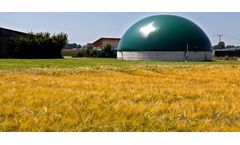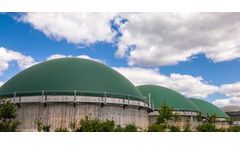Refine by
Anaerobic Digestion System Articles & Analysis
92 articles found
Critical considerations for anaerobic digestion projects In the field of industrial wastewater treatment, anaerobic digestion is a powerful process that transforms waste into valuable by-products. Most notably, it produces renewable energy in the form of biogas, which can be used to fuel operations, cogenerate electricity, or even be sold. Another valuable by-product of the process is digestate, ...
Wastewater treatment plants, food waste facilities, and landfill gas recovery systems utilise anaerobic digesters to break down organic matter. This digestion process produces biogas—a mixture of methane and carbon dioxide. ...
The annual processing capacity of the plant is approximately 130,000 tons of agricultural biomass, including corn and straw. The biogas generated will be used as a substitute for natural gas for transportation and injected into the natural gas pipeline network. ...
Methane is a potent greenhouse gas but it’s also highly combustible, making it a valuable source of renewable energy when captured. Anaerobic digesters can convert farm waste into methane-rich biogas, leaving the solid and liquid residues to be used as a nutrient-rich fertilizer. By recovering nutrients for reuse, anaerobic ...
Legislation has potential to boost biogas use across the US When anaerobic digestion is used to process wastewater with a high organic load, it produces energy in the form of biogas, a combination of methane, carbon dioxide, and other gases. In the United States, there is huge potential for expansion in anaerobic digestion, but even though the energy produced can more than pay for the treatment, ...
Anaerobic digestion can turn waste into a valuable resource Billions of tons of organic waste are generated every day by households, industries, and municipalities. It’s discarded into landfills or discharged as effluent, or both, at a huge cost to the environment. But what if that waste could be turned into energy? The good news is that it can, through anaerobic digestion. In anaerobic ...
In the dairy industry, the production of biogas can be profitable, even for small farms Dairy farms must deal with wastewater that’s particularly high in organic matter and that can be challenging to deal with. However, establishing an on-farm anaerobic digestion plant that generates biogas from cattle slurry offers several benefits: It captures methane and converts it into a renewable ...
Biogas, a methane-rich mix of gases created by anaerobic digestion, can be burned to generate electricity or heat, or it can be processed further to produce a valuable source of renewable energy. Different technologies can be used to tailor a solution that makes the most of specific feedstocks Anaerobic digestion is a natural biological process in which bacteria decompose organic matter in ...
Food and beverage operations are ideally positioned to enter the circular economy with waste-to-energy systems The food and beverage (F&B) industry is known for its high-load wastewater. ...
Anaerobic digestion is a biological process in which microorganisms break down organic matter without oxygen and transform them into end-products, including biogas, an energy-rich gas comprised of methane (CH4), carbon dioxide (CO2), and other trace amounts of gases. Anaerobic digestion can be summarized as a four-stage process (1) hydrolysis, (2) acidogenesis, (3) acetogenesis, and (4) ...
With an underdeveloped waste-to-energy market, new legislation promotes greater adoption of anaerobic digestion On August 16, United States President Biden signed the $750 billion Inflation Reduction Act (IRA) into law and biogas industry groups immediately hailed its hefty incentives for anaerobic digestion, a technology that recovers energy from waste in the form of ...
“We know that local residents still have questions, and we encourage them to attend tonight’s public hearing or send us questions at bioenergyic.com, including in Spanish and Haitian Creole.” Anaerobic digestion is a natural process that operates much like a cow’s stomach; the technology used for commercial anaerobic ...
Converting dairy waste into biogas and other valuable resources trims disposal costs, and saves water and energy Dairy and livestock farmers have been reaping the benefits of converting animal waste into biogas through anaerobic digestion. Now dairy processors are following suit by recycling the organically rich waste that they generate. Instead of discharging waste byproducts into the ...
The anaerobic digestion process is typically used as a means of waste disposal or energy production. ...
Since 1970, Revico and its subsidiary Revico Energies Vertes have been utilising the by-products of the Cognac sector. Located in Saint-Laurent-de-Cognac (Charente), the company specialises in the treatment of effluents from the production of spirits, such as vinasses or wine dregs. ...
The CH4 and CO2 content of the product gas stream is often measured by anaerobic digestion process control systems to assess the process and indicate the presence of any issues within the system.1,6 The UK Researchers used CH4 and CO2 sensors from Edinburgh Sensors in their study to track and optimize the process. This is the ...
In the case of WWTPs, it is also necessary to add particles, sediments, condensates and typical foams in biogas from anaerobic digesters to the impurities or contaminants that biogas has. In general terms, a biogas installation in a WWTP has the following stages: Production/generation of biogas. Anaerobic sludge digestion ...
Anaerobic digestion as a means of treatment and recovery of WWTP sludge. ...
Removal of water vapor Origin In the biogas production process, water is an intrinsic part of both the material to be digested (biomass) and the process itself. Furthermore, water is the medium in which biogas production takes place, regardless of whether the digestion process is dry or wet, the biogas produced will contain water vapour. The amount of water ...
Its composition is intimately related to the type of matter that is subjected to the anaerobic digestion process, and a certain extent, to the technology used for its production. UNCONTROLLED SYSTEMS. LANDFILL BIOGAS, LANDFILLS, SWAMPS Controlled systems. Urban wastewater treatment plant (wwtp) and anaerobic ...















